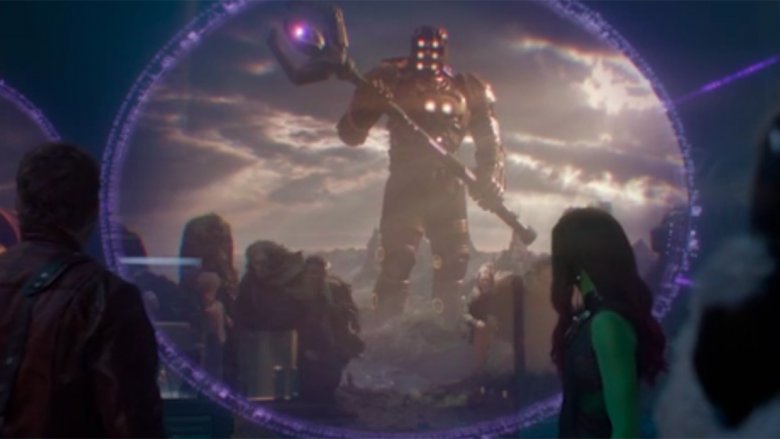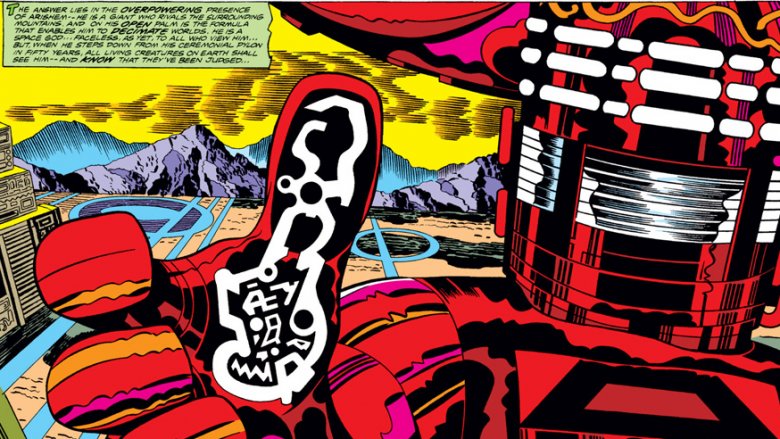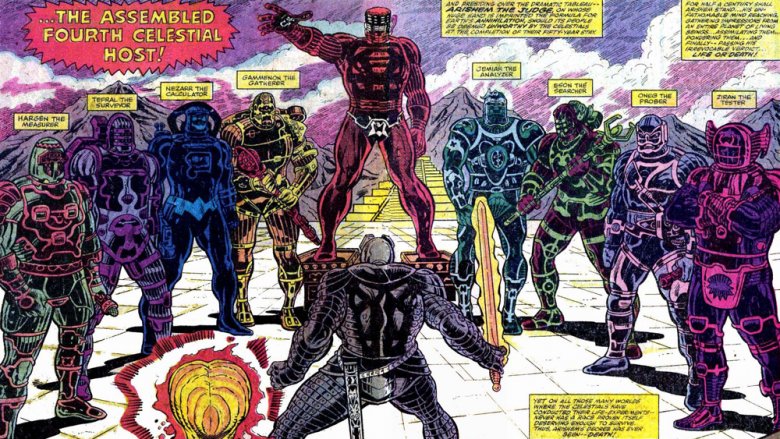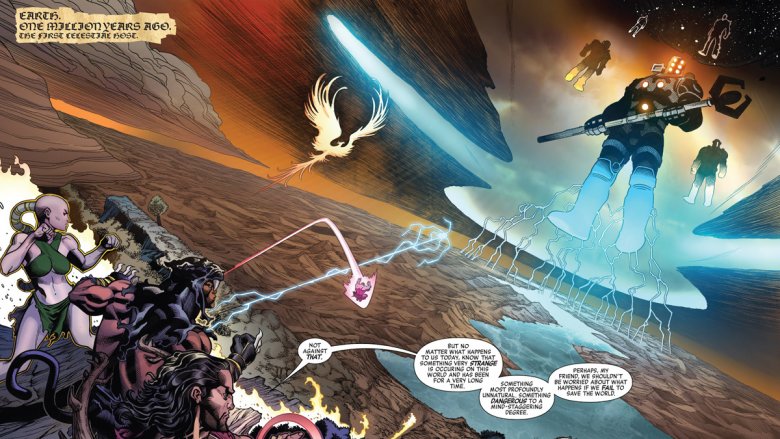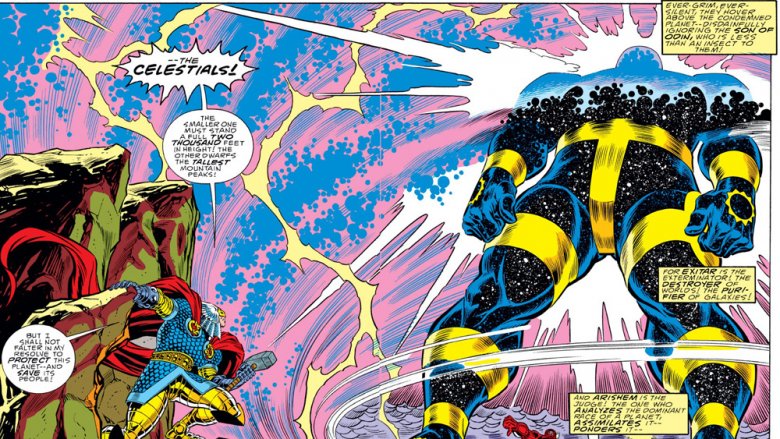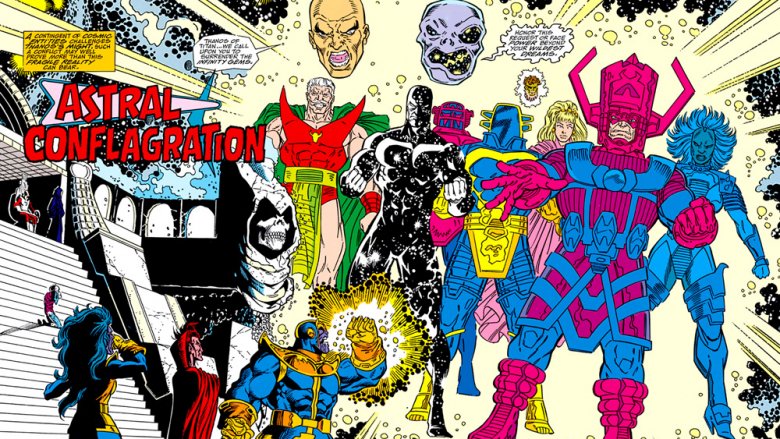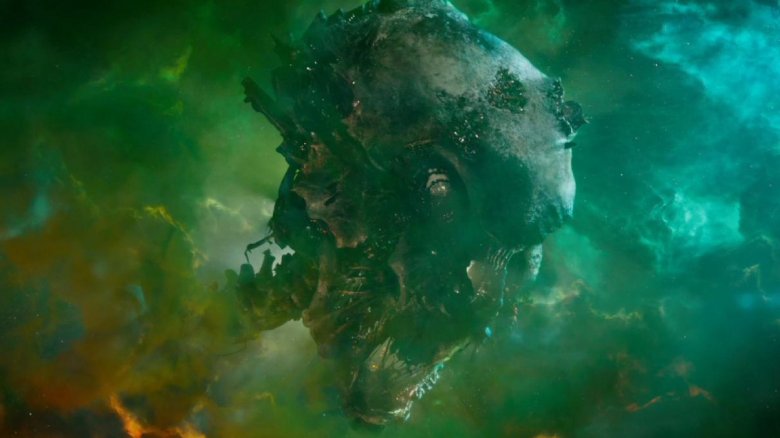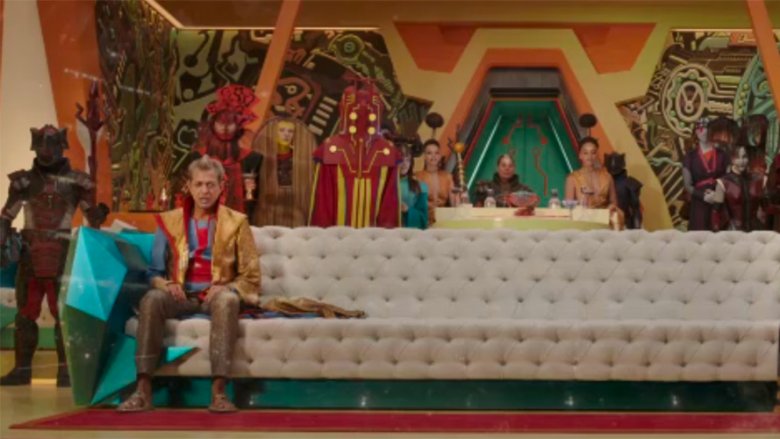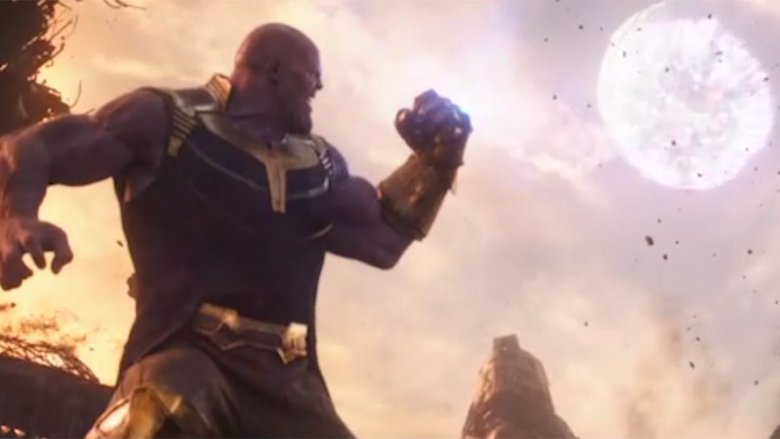How The Celestials Could Play A Part In Endgame
The Marvel Cinematic Universe has been operating on a truly cosmic scale for a while now. Guardians of the Galaxy took place almost entirely in space and introduced moviegoers to star-faring adventurers, the Nova Corps, and the Collector. But the groundwork was laid even before that with the introduction of Thanos and an invasion of the Chitauri all the way back in the very first Avengers movie. In Infinity War, though, all of that cosmic action came home, as Thanos finally came to Earth and, with a single snap of his fingers, killed half of the sentient life in the universe.
The effects of the Mad Titan's universal genocide were immediate, but they also set the stage for Avengers: Endgame. When the heroes of the MCU return to action in 2019, they may need to turn to a cosmic force of their own to help defeat Thanos once and for all, and if they do, there are few that could be as potent as the Celestials. We've got some theories on how these towering space gods might play a part in Endgame — and how they've already been introduced to the MCU, even if you didn't notice.
The cosmic history of the Celestials
If you're wondering who we're talking about when we mention the Celestials, don't worry. Unlike most of the other characters featured in the MCU, they're relatively obscure. They have, however, had a pretty huge impact across the Marvel Universe, and it all began in 1976.
When Jack Kirby, the legendary artist who co-created the Marvel Universe alongside Stan Lee, returned to Marvel after a stint at DC, he launched a handful of notable new projects. One of them was a run on Captain America that led to a massive celebration of the bicentennial, and another was Devil Dinosaur, which was about a super-powered Tyrannosaurus Rex who fought aliens. Needless to say, it ruled hard. Slightly more obscure, however, was The Eternals, which introduced both the titular race of immortal, super-powered humans and the Celestials.
In a lot of ways, this was an extension of what Kirby had been doing at DC with the New Gods — including Darkseid and Steppenwolf, who showed up in the Justice League movie — but rather than operating as personifications of godly concepts, the Celestials were a little more Lovecraftian. They were essentially space-gods, massively powerful cosmic entities who had been traveling the universe for millions — if not billions — of years, seeding planets with new life and manipulating it as part of a vast universal scientific experiment. They were the ones responsible for creating the Deviants and manipulating various cosmic races, including humanity. That idea, of life in the universe being the result of some cosmic science experiment which could be ended at any time, was at the core of the Celestials for the next 50 years.
The Judge, the Exterminator, the Seeker, and more
If being space gods the size of skyscrapers clad entirely in armor who were possibly responsible for the entire evolutionary history of humanity didn't make them intimidating enough, each of the Celestials was given a name that described their function in the grand experiment. True to form, many of these were geared towards their scientific specialties: Gammenon the Gatherer was responsible for acquiring samples of the Celestials' genetic experimentation, which would then be handed off to Jemiah the Analyzer and Hargen the Measurer — for, well, analysis and measuring, respectively — all subject to the approval of The One Above All.
There were, however, a few that were far more intimidating than those, and chief among them was Arishem the Judge. His role was to determine the success of the various experiments, which he would do in a beautifully literal fashion: after observing each planetary petri dish for fifty years (the blink of an eye on the Celestials' cosmic time scale) he would indicate the results of his judgment through the "formula for world destruction" that was inscribed on his right hand. In other words, he'd give the whole world a thumbs up or thumbs down.
He wasn't the one who would do the actual destroying, though. That job fell to the most intimidating of the Celestials, the appropriately named Exitar the Exterminator. When an experiment was determined to have failed, he would descend from the heavens and obliterate entire planets in order to "clean up" the failures of their unknowable science. Keep him in mind, he's going to be important later.
The Celestials and the Avengers
Given their history of manipulating various planets with a pretty thorough disregard for human life, it shouldn't come as a surprise that the Celestials have battled the Avengers on more than one occasion. Most recently, they were featured in a story that spanned a million-year history of the Marvel Universe, which is especially notable since they were up against the very movie-friendly lineup of Captain America, Iron Man, Thor, Black Panther, Doctor Strange, Captain Marvel, She-Hulk, and Ghost Rider.
The same story also revealed that a pair of diseased and mutated Celestials known as the Progenitor and Zgreb the Aspirant, had come to Earth "one million years ago," and that Zgreb had fought and been defeated by the "Avengers" of that time. The Stone Age Avengers, as they would come to be known, consisted of Odin, the Phoenix Force, Starbrand, the very first Iron Fist and Black Panther, Agamotto (of "Eye of" fame), and a primeval version of Ghost Rider who, instead of riding a flaming motorcycle, rode around on a fiery skeletal mammoth. For the record, this also ruled. Unfortunately, when the other Celestials came looking for their fallen comrades, these prehistoric heroes weren't enough to stop them from nearly obliterating Earth then.
The important revelation of the story was that the disease that had mutated the Progenitor had seeped into the Earth itself, and eventually led to the Marvel Universe's massive population of superhumans. Whether they were a symptom of a diseased planet or the Earth's attempt at creating antibodies to fight off the threat of a cosmic infection remains to be seen.
Beyond the power of gods
If you're looking for a story that encapsulates the sheer power of the Celestials, then you might want to dig through a back issue box for Thor #387 – 390, by Tom DeFalco and Ron Frenz.
In that story, the God of Thunder finds himself on a planet called Pangoria when Arishem the Judge, described several times as being 2,000 feet tall, descends to pass his verdict on the planet. He apparently finds the Pangorians to not be up to his standards, and gives them the dreaded, gigantic thumbs down that heralds their doom. Thor, of course, stands up for the innocent people of Pangoria, and spends an entire issue fighting against Arishem, only to find out that the Celestial never even noticed his presence. Then, to make things worse, Arishem's signal is received, and Exitar the Exterminator, drawn to be ten times bigger than Arishem, arrives to carry out the sentence.
Using all of his considerable might, Thor cracks open a tiny hole in Exitar's armor, but even after channeling the raw power of the gods through Mjolnir — enough force to shatter his theoretically unbreakable hammer — Exitar remains upright and carries out his duty. The good news, though, is that the Celestials really just wanted to restore Pangoria's extinct vegetation, and after noting Thor's valor, they patch up his hammer and send him back to Earth. Given the hassle that the MCU's Thor went through after his version of Mjolnir was broken, the fact that the Celestials can do it with a thought should give you an idea of just how powerful they are within the Marvel Universe.
Infinity Gauntlet
As you may already know, Avengers: Infinity War was heavily inspired by the events of Infinity Gauntlet, the 1991 comic book event where Thanos first got his hands on all six Infinity Stones and forged them into his all-powerful gauntlet. Scenes like a hero crashing into Doctor Strange's Sanctum Sanctorum to warn Earth's heroes of the threat they were facing, specific visuals like Thanos turning his enemies into piles of cubes or spirals, and even the universe-rending finger-snap were lifted directly from the comic.
While it's mostly remembered for scenes of superheroes facing off against Thanos in the depths of space — and losing quite badly and brutally in the process — Infinity Gauntlet's massive battle was eventually joined by the Celestials. Along with other cosmic forces like Galactus, Eon, the Stranger, and even Eternity itself, the Celestials realized that Thanos could use his newfound omnipotence to usurp them, and joined together to stop him. It did not exactly work out.
But it does give an indication of how the Celestials could be involved in the events of Endgame. If their history in the MCU is anything like their history in the comics, then they have a vested interest in sentient life — not just on Earth, but throughout the universe. In their long history of experimentation, they've interacted with some of the interstellar species that we've already seen in the Guardians movies, and specifically with the Kree, who will be featured in the upcoming Captain Marvel. Even if they're only interested in their experiments, wiping out half of the universe has undoubtedly caught their attention.
They're already here
All of this raises the question of just how the Celestials could be introduced into the MCU, but here's the thing: they're already there, and they have been for a while.
Way back in 2014's Guardians of the Galaxy, the Guardians bring the Collector the Orb, only to find out that it's actually the Power Stone. While explaining his new treasure, the Collector shows them a video of what is unmistakably one of the Celestials, probably Exitar the Exterminator, laying waste to a planet. Also, Knowhere, the outer-space settlement where all this happens, is — just like the Knowhere of the comics — built from the head of a dead Celestial.
That's interesting for several reasons. Not only does it confirm the existence of these cosmic forces in the MCU, it also connects them to the Infinity Stones. That's a connection that doesn't really exist in the comics, but the idea that the Celestials have used the stones for their own purposes before, and possibly even created them, ties them into the ongoing plot that has been running through the entire franchise. Of course, it might just be an Easter egg for die-hard Marvel fans and a convenient illustration of the Stones' power, but it definitely also puts the Celestials in a position where they could have an interest in taking their property back from Thanos.
The relatively tiny Celestials of Ragnarok
In addition to their very on-brand appearance in Guardians of the Galaxy, the Celestials might've made an appearance in 2017's Thor: Ragnarok. This one, however, is a little more debatable.
When Thor takes on the Hulk in the Grandmaster's Contest of Champions — a scene that's already loaded down with references to various Marvel comics, including the Planet Hulk storyline — there are plenty of shots of the Grandmaster taking in the action from his private box. Standing right behind him is a figure who bears a striking resemblance to Arishem the Judge. In all honesty, this might just be an example of one of Ragnarok's many Jack Kirby-inspired visual touches. The background in the scene is clearly lifted from Kirby's signature tech designs, and most of the guards and soldiers in the Grandmaster's employ have Kirby-esque designs to their armor.
Then again, it might be something more. The "Arishem" of Ragnarok is definitely not 3,000 feet tall, but if Ulysses Klaue can be a flesh-and-blood Andy Serkis instead of a sentient hot pink soundwave, then there are certainly other changes that could be made, too. The size variation could just be taking the idea from Thor #388 to its extreme, Or maybe this person could just be an Arishem cosplayer. Given what we know of how weird Sakaar is in that movie, that's not actually out of the question.
The Celestials of Endgame
So, what does all this mean for Endgame? Like a lot of speculation, it could be nothing — the trailer that we've seen so far doesn't mention the Celestials. The focus is instead on the characters that we already know and love, like Iron Man and Captain America, and it should be. You don't go to a movie called Avengers to see people who aren't the Avengers, right?
That said, if the MCU does opt to bring in a focus on the Celestials, the material is already in place to support them. We know they exist on-screen, they have a connection to the original Infinity Gauntlet story, and they're definitely the kind of beings who would be concerned about what Thanos had done to the universe. It's also worth noting that at the end of Infinity War, Thanos is happy and apparently free of consequences for the actions that he still believes were right all along, on a farm somewhere out in the universe. There has to be something to bring him back into play, unless Infinity War really did have the darkest ending of all time.
No matter what happens, it's hard to believe that the Celestials would serve as some kind of deus ex machina that arrives to save the day — the films just aren't built like that. They are, however, exactly the kinds of cosmic forces that could remind moviegoers of the epic stakes that our heroes are dealing with, and with at least one Avenger floating off in the depths of space, somebody's going to have to scoop him up. Let's just hope it's not Exitar.
